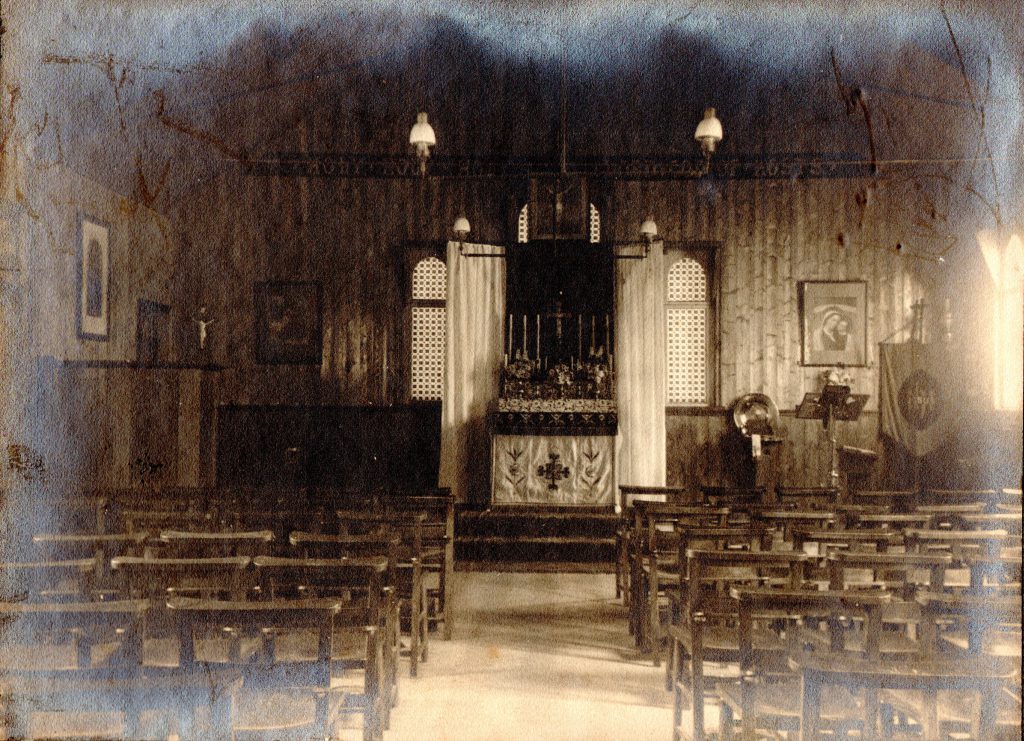As early as 1903, a year before the completion of the Parish Church, St. Alban’s had established a mission centre in the northern part of its Parish. A modest beginning was made in that year by renting a house in Newlands Road, where services were held and a Sunday School established. The success of this venture led to a desire for a larger and permanent home for St. Alban’s Mission, as it was then called, and in 1905, largely through the munificence of Sister Agnes, one of the Parish’s greatest benefactresses, a site was secured at the junction of Salisbury and Cliff Avenues for the erection of a permanent mission building.

An iron structure on a concrete and brick foundation was built at a cost of £1,000 it had accommodation for 160 people and was consecrated by the Bishop of St. Albans on the 11th November 1905. This new Mission, known as the “The Mission of the Holy Name,” at once became the centre of a vigorous and active religious life. In the early days the Mission was directed entirely by the Rev. F. E. Rance, a sincere and courageous Priest who attracted all classes to a spiritual life by his fearless teaching of the Catholic Faith, his intense human sympathy and self-sacrifice in the cause of winning souls to Christ.
His task at first was not easy. He had to struggle against bands of young hooligans who infested the northern area of the Parish and periodic visits from the Kensitites who came annually into the Parish in an attempt to disturb the Good Friday Procession of Witness. It is recorded that when he first launched a club for young lads, when the new Mission Room had been completed, the hooligans in the Parish turned up in strength to take a rise out of him and wreck the whole concern.
Fr. Rance had apparently learnt the art of boxing in his student days and the first man to start wrecking tactics was promptly stretched out on the floor. The reputation of “the fighting parson” was made. Those who had come to scoff remained to pray and the gang leaders some twenty in all were eventually baptised and confirmed becoming some of the keenest supporters of the Mission’s social and religious activities.
Henceforth the young lads of the club were known as “Miss Simpson’s Lambs” Miss Simpson was the church worker at the time and a very loyal supporter of Fr. Rance’s work. Her enthusiasm and magnetic personality drew large numbers of men, women and children to God and in particular those very hooligans who at first had seemed such hopeless propositions. The Mission Room became self-supporting and held a full complement of services which were always crowded. The intensity of its spiritual life may be gathered from the fact that once a week an Early Mass was celebrated at 4.30am this was attended by early workers such as road menders, gardeners, tram drivers and conductors, milk men and post men.
All the fittings of the Mission Room, including the altar rail and pulpit were made by the men of the Mission in their own time and were given. Only the altar came from elsewhere, this being a gift from Sister Agnes, it had formerly belonged to the Community of which she was a member. It is this altar which now stands in the North Aisle (Holy Name Chapel) of the Parish Church**.
The debt on the Mission building was cleared by 1908 and the Mission continued to do excellent work down to the year 1922. In that year owing to the increase in population in Westcliff-on-Sea the new ecclesiastical Parish of St. Paul’s was created out of the parishes of Prittlewell and St. Alban’s, Westcliff-on-Sea, and the Mission of the Holy Name found itself within the newly created Parish of St. Paul’s. It was therefore impossible to continue it as a parochial activity. Some people had hoped that the Mission might be transferred to a site in Station Road at the southern end of the Parish, but the Parochial Church Council accepted the decision of its General Purposes Committee which unanimously recommended that the best interest of the Parish would be served by centralizing the spiritual work of the Parish around the Parish Church.
This decision was partly due to the fact that expert evidence had decided that the Mission Room would not survive dismantling and re-erection and partly due to the excessive price demand for a new site. The sale of the building was transacted through the Charity Commissioners who agreed that the proceeds should be devoted to St. Edward’s Hall and the purchase of 6 St. John’s Road***. Sister Agnes agreed to this arrangement.
** Since this article was first published in 1948 the altar in the North Aisle from the Mission Room has been replaced, I believe the original Mission Room altar was moved to the platform in the Nave, the Sunday Mass is conducted from this altar.
*** In 2003 the Parochial Church Council of Southend Parish agreed to the sale of 6 St. John’s Road following the death of our Verger Len Eastland who lived there for over 40 years.
All the information shown on this page is taken from “Saint Alban the Martyr St. John’s Road Westcliff-on-Sea The First Fifty Years 1898 – 1948” by L. E. Britnor and G. E. Smith published Easter, 1948.



